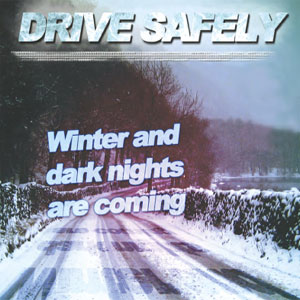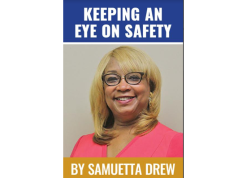AAA ALABAMA RECOMMENDS CAUTION FOR WINTER DRIVING
Birmingham, AL – With the possibility of icy roads across Alabama this week, drivers should be prepared to adjust their driving behavior. Severe weather can be both frightening and dangerous for automobile travel. Motorists should know the safety rules for dealing with winter road emergencies. AAA reminds motorists to be cautious and slow down while driving in adverse weather. To minimize the dangers associated with winter driving, AAA Alabama recommends the following winter driving tips and techniques:
GETTING UNDERWAY – To see and be seen by others requires the driver to clean all snow and ice from the vehicle — hood, roof, trunk, lights and windows. Snow left on any of these areas increases the possibility that visibility will be affected when the vehicle is in motion. Try to avoid driving when visibility is poor; if you must drive, keep your speed low, headlights on low beam and if needed pull off to a safe spot as soon as possible.
FOLLOWING – Normal following distances for dry pavement (two to three seconds) should be increased to eight to 10 seconds when driving on icy, slippery surfaces. This increased margin of safety will provide the longer distance needed if you have to stop suddenly.
STEERING – Snowy and icy surfaces make steering difficult and require smooth, careful, precise movements of the steering wheel. Skidding in which the front or rear move laterally is caused by hard acceleration or braking, speeds to fast for conditions, and quick jerky movements of the steering wheel. 4×4 vehicles can lose traction as easily as 2-wheel drive vehicles.
BRAKING – Stopping on slippery surfaces requires longer visibility, following and stopping distances. The heavier the vehicle then longer it will take to stop. The stopping distance required on ice at 0 degrees Fahrenheit is twice the amount required at 32 degrees Fahrenheit. Shaded spots, bridges, overpasses and intersections are areas where ice is likely to form first or be the most slippery, because the shiny ice surface has either been polished by previous traffic, or a thin layer of water covers the melting ice below. When road conditions change, so do braking requirements.
SKIDS – In a skid, it’s important to regain control of your vehicle, especially if it skids sideways. Don’t panic-decelerate by easing your foot off the gas if the wheels lose traction due to hard acceleration. Take your foot off the brake if the wheels skid due to hard or panic braking. As you’re the wheels begin to grip the road, look in the direction you want your vehicle to go and gently steer in the direction you want the vehicle to go.
PREPARATION – It’s always a good idea to have some things in your car in case of a breakdown or other emergency. Things like blankets, gloves, bottled water, snacks, extra coats, a tool kit, first aid kit, battery cables, a flashlight, and most importantly a cell phone can be very helpful in an emergency. Few people plan to be stranded on the side of the road, but it’s always a good idea to have these things with you, just in case.
AAA recommends the following winter driving tips:
- Avoid driving while you’re fatigued. Getting the proper amount of rest before taking on winter weather tasks reduces driving risks.
- Never warm up a vehicle in an enclosed area, such as a garage.
- Make certain your tires are properly inflated.
- Never mix radial tires with other tire types.
- If possible, avoid using your parking brake in cold, rainy and snowy weather.
- Do not use cruise control when driving on any slippery surface (wet, ice, sand).
- Always look and steer where you want to go.
- Use your seat belt every time you get into your vehicle.
Tips for long-distance winter trips:
- Watch weather reports prior to a long-distance drive or before driving in isolated areas. Delay trips when especially bad weather is expected. If you must leave, let others know your route, destination and estimated time of arrival.
- Always make sure your vehicle is in peak operating condition by having it inspected by a AAA Approved Auto Repair facility.
- Keep at least half a tank of gasoline in your vehicle at all times.
- Pack a cellular telephone with your local AAA’s telephone number, plus blankets, gloves, hats, food, water and any needed medication in your vehicle.
- If you become snow-bound, stay with your vehicle. It provides temporary shelter and makes it easier for rescuers to locate you. Don’t try to walk in a severe storm. It’s easy to lose sight of your vehicle in blowing snow and become lost.
- Don’t over exert yourself if you try to push or dig your vehicle out of the snow.
- Tie a brightly colored cloth to the antenna or place a cloth at the top of a rolled up window to signal distress. At night, keep the dome light on if possible. It only uses a small amount of electricity and will make it easier for rescuers to find you.
- Make sure the exhaust pipe isn’t clogged with snow, ice or mud. A blocked exhaust could cause deadly carbon monoxide gas to leak into the passenger compartment with the engine running.
- Use whatever is available to insulate your body from the cold. This could include floor mats, newspapers or paper maps.
- If possible run the engine and heater just long enough to remove the chill and to conserve gasoline.
Tips for driving in the snow:
- Accelerate and decelerate slowly. Appling the gas slowly to accelerate is the best method for retraining traction and avoiding skids. Don’t try to get moving in a hurry. And take time to slow down for a stoplight. Remember: It takes longer to slow down on icy roads.
- Drive slowly. Everything takes longer on snow-covered roads. Accelerating, stopping, turning – nothing happens as quickly as on dry pavement. Give yourself time to maneuver by driving slowly.
- The normal dry pavement following distance of two to three seconds should be increased to eight to ten seconds. This increased margin of safety in front will provide the longer distance needed if you have to stop.
- Know your brakes. Whether you have antilock brakes or not, the best way to stop is threshold breaking. Keep the heel of your foot on the floor and use the ball of your foot to apply firm, steady pressure on the brake pedal.
- Don’t stop if you can avoid it. There’s a big difference in the amount of inertia it takes to start moving from a full stop versus how much it takes to get moving while still rolling. If you can slow down enough to keep rolling until the light changes, do it.
- Don’t power up hills. Applying extra gas on snow-covered roads just starts your wheels spinning. Try to get a little inertia going before you reach the hill and let that inertia carry you to the top. As you reach the crest of the hill, reduce your speed and proceed down hill as slowly as possible.
- Don’t stop going up a hill. There’s nothing worse than trying to get moving up a hill on an icy road. Get some inertia going on a flat roadway before you take on the hill.
- Stay home. If you really don’t have to go out, don’t. Even if you can drive well in the snow, not everyone else can. Don’t tempt fate: If you don’t have somewhere you have to be, watch the snow from indoors.
With eleven offices across Alabama and more than one thousand offices nationwide, AAA is North America’s largest motoring and leisure travel organization. AAA provides travel, insurance, financial and automotive-related services to more than 364,000 Alabama members and more than 54 million members nationwide. Since its founding in 1902, the not-for-profit, AAA has been a leader and advocate for the safety and security of all travelers. AAA clubs can be visited on the Internet at www.AAA.com.
-AAA-





